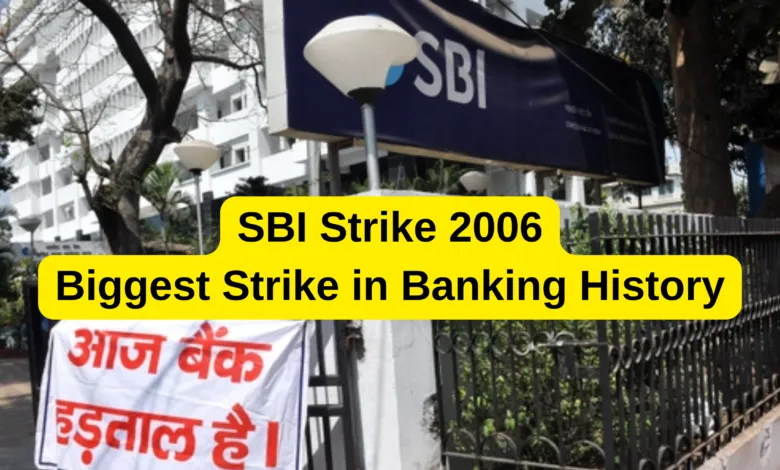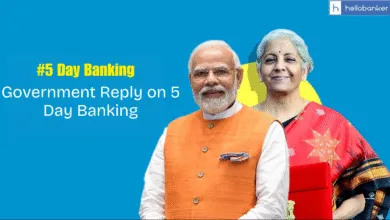2006 SBI Strike – Biggest Strike in Indian Banking History

| ➡️ Get instant news updates on Whatsapp. Click here to join our Whatsapp Group. |
Imagine waking up one morning and finding that all the banks in the country are closed. You go to withdraw cash, but the ATM is empty. Businesses cannot deposit or withdraw money. Cheques are not cleared. Salaries are stuck. The entire economy slows down. Sounds like a nightmare, right?
But this was not just a scary thought—it actually happened in April 2006, when State Bank of India (SBI), the largest bank in India, remained shut for an entire week due to a massive strike by its employees. The strike had a huge impact on the country’s financial system, affecting millions of people and businesses.
On April 3, 2006, more than two lakh employees of the State Bank of India (SBI) went on an indefinite strike across India. This meant that they stopped working completely, and no banking services were available in all 9,000 branches of SBI. The main reason for the strike was the demand to revise the pension scheme, which had not changed for many years.
Why Did SBI Employees Go on Strike?
The strike was not sudden. The employees of SBI had been demanding a revision in their pension for 14 years, but their requests were ignored by the government. Their demands were:
- Low Pension Ceiling – An increase in the pension due to employees, to 50 per cent of the last pay drawn, in place of the minimum of Rs 4,500 at present. This minimum had been set with reference to the pay scales of 1992 and needed to be revised. This matter had been pending, according to the strikers, for 14 years, and there was no response to their demands.
- No Family Pension Revision – The family pension (given to employees’ spouses after their death) had not been revised for 20 years, making it extremely low.
- Other Demands – SBI employees wanted:
- Pension equal to 50% of their last salary
- A better commutation policy (lump sum payment of pension)
- Dearness allowance (DA) linked to inflation, like in other banks
- Upgrading pension of retired employees based on the current inflation rate
SBI was the first bank in India to introduce a pension scheme for its employees many years ago. Later, the Indian Banks’ Association (IBA) and other banks also introduced pension schemes. Even the Reserve Bank of India (RBI) started a pension plan for its employees. However, over time, the pension benefits for SBI employees did not improve. The employees felt that they were being treated unfairly, despite SBI being India’s largest and most profitable bank. So, they decided to go on strike to make their voices heard.

The strike was led by two major unions representing SBI employees:
- All India State Bank Officers’ Federation (AISBOF) – Representing SBI officers
- All India State Bank of India Staff Federation (AISBISF) – Representing SBI staff members
Both unions came together and decided that they would not return to work until their demands for fair pension benefits were accepted by the government.
How the Strike Affected the Country
Since SBI handles about 25-30 million transactions daily, the strike had a huge impact:
🚫 Banking services were completely disrupted – All 9,000 SBI branches across the country were shut. No one could withdraw or deposit money.
🚫 Cheque clearing was affected – Since SBI manages a large portion of cheque clearing operations, lakhs of cheques were stuck. To manage the crisis, the Reserve Bank of India (RBI) took over some cheque clearing operations, but this was only a partial solution because SBI transactions could not be processed.
🚫 Forex and call markets suffered – Businesses involved in foreign exchange and stock trading faced difficulties as their transactions couldn’t be processed.
🚫 ATMs ran out of cash – In the beginning, ATMs were still working, but as they ran out of money, they too stopped functioning.
🚫 Government payments were delayed – Many government payments and subsidies that were processed through SBI could not be completed.
With no resolution in sight, daily protests were held outside SBI branches. Even retired SBI employees and pensioners joined the demonstrations, demanding justice.
A Tough Battle: Government’s Resistance
The government, especially the Finance Ministry, was hesitant to accept the demands. Officials feared that if SBI employees got a higher pension, employees from other public sector banks might demand the same.
The Labour Minister tried to mediate, but no solution was reached. SBI management and union leaders were willing to discuss, but the government did not make any concrete promises. The government wanted to push the New Pension Scheme (NPS), which was introduced for government employees in 2004. Unlike the traditional defined benefit pension (where retirees get a fixed pension amount), NPS is a market-linked system, which is riskier.

Meanwhile, pressure was increasing. The strike was causing huge financial losses to the country. The public was suffering, and the economy was in trouble. Finally, after one full week, the government decided to take action.
Despite discussions with the Labour Minister and Finance Ministry officials, no immediate solution was reached. The government asked employees to wait until the state elections were over, but the unions refused because there was no guarantee of a resolution after elections. The Chief Labour Commissioner tried to mediate, but the Finance Ministry refused to change its stand, causing the strike to continue.
The Final Agreement: Victory for SBI Employees
On April 8, 2006, after intense negotiations between SBI management, employee unions, and top Finance Ministry officials, a new pension formula was agreed upon.
✅ The basic pay for pension calculations was increased from ₹8,500 to ₹21,040.
✅ Employees earning ₹21,040 or less would receive 50% of their last salary as pension.
✅ For those earning more than ₹21,040, they would get 40% of the amount above this limit.
This agreement was seen as a major victory for SBI employees. With their demands met, the strike was officially called off on April 9, 2006.
Who Was Responsible for the Chaos?
The biggest question remains: Why did the government delay the decision for 14 years? If the government eventually accepted the demand, why did the public have to suffer for a whole week? This strike exposed the stubborn attitude of the Finance Ministry, which refused to listen to genuine demands until the situation became a crisis.
Lessons from the SBI Strike
This historic strike proved that when employees unite and fight for their rights, they can bring about real change. It also showed how delayed decisions by the government can cause unnecessary suffering to the public.
Even today, pension reforms and employee rights remain important issues. The SBI strike of 2006 remains a powerful example of how financial workers play a crucial role in keeping a country’s economy running smoothly.
Many believed that the delay happened due to the Finance Ministry’s ego and reluctance to accept employees’ genuine demands. The strike showed that unity and determination can help employees achieve fair treatment even against powerful institutions. The 2006 SBI strike remains one of the biggest banking strikes in India, proving that when employees stand together for their rights, they can bring about real change.
What do you think? Should such strikes be necessary for employees to get their rights, or should governments act faster to prevent such situations? Let us know in the comments! 🚀

We bankers has to do one week strike too
Avoid such situations
Government should act faster otherwise strike is necessary
तो फिर हो ही जाए एक बार फिर से
आ देखें जरा अ र र किसमे कितना है दम
जम के रखना कदम मेरे साथिया आ आ आ आ